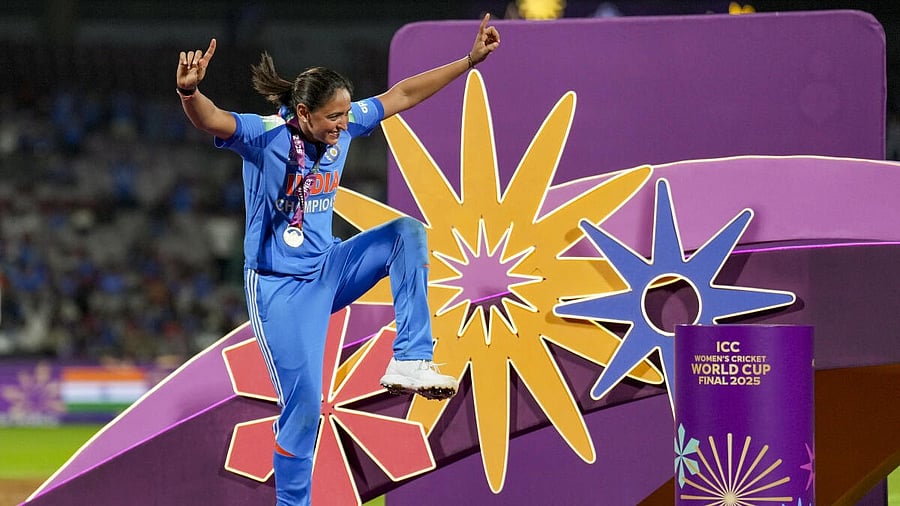
Harmanpreet Kaur does a 'bhangra' celebration during presentation ceremony.
Credit: PTI Photo
Navi Mumbai: Harmanpreet Kaur now knows how it feels to win a World Cup. It was her self-belief that kept her and her team going over nine matches across five weeks ending with her lifting the Cup on Sunday.
“There were ups and downs but the team had self-belief. We weren’t looking to the left or right. We were only looking straight at our main goal that was to lift the trophy,” said Kaur with the Cup placed in front of her on the table while addressing the media after the final.
In August this year, Kaur, ace batters Smriti Mandhana and Jemimah Rodrigues were at the 50-day countdown to the start of the World Cup in Mumbai and were determined to emulate their male counterparts who achieved World Cup glory at home in 2011.
The star of India’s triumphant campaign 14 years ago, Yuvraj Singh, reminded the girls that it was not going to be a joy ride playing a World Cup in front of home fans. He reminded them of having a single-minded focus on lifting the trophy by shutting out all the outside noises.
It was, indeed, not an easy ride for India. Having won in their first two matches against Sri Lanka and Pakistan, India faced three straight defeats against stronger opponents. They began to feel the pressure of a home World Cup and also the expectations from a billion followers.
They were criticised for not being able to finish off matches from winning positions. That was their undoing in those losses to South Africa, Australia and England. They were also reliant on their openers Mandhana and Pratika Rawal to do the bulk of the scoring, which they did, but their middle-order was consistently inconsistent.
Kaur, herself, did not have a good run except for the 70 against England in the league stage and the 88 in the semifinal. Harleen Deol, the No. 3 in the first five matches, did not have a healthy strike nor did she convert her 20s, 30s and 40s into bigger scores. Deol had to eventually give her spot to Jemimah Rodrigues.
The lower middle order led by the ever-reliable Player of the tournament, Deepti Sharma often bailed the team out. She had good company in Richa Ghosh, Amanjot Kaur and Sneh Rana who made vital contributions that held the team stick together throughout.
A home World Cup can be mentally draining. Between the heartbreaks were some silver linings that gave them belief they could lift the World Cup. Shifting the matches from Bengaluru and including DY Patil Stadium in its place came as a boon.
“As soon as we knew that our venue had been changed to DY Patil Stadium, we all got so happy because we’ve always played good cricket there. The biggest thing is the crowd. It’s always supportive. We all started messaging in the group. We were manifesting. We said, ‘The final is going to be there — we won’t leave it now’,” Kaur said.
Barring the league match against Bangladesh, which ended in No Result due to rain, India won all their matches at this venue. They were all do or die ones.
Against New Zealand in the league stage, it was a virtual quarterfinal, and India posted the highest total batting first, their 340 for three enough to win and book their semifinal berth. In the last four against Australia, they came up with a world record chase in ODIs anchored sensationally by Jemimah Rodrigues’s unbeaten century in the last four. That knock gave many soul-searching answers to her own game, more so after being dropped for the game against England.
And in the final, the player who did not even figure in the original squad but was recalled after a one-year hiatus in WODIs, Shafali Verma did wonders.
Not only did she score a remarkable 87 in the final but also bowled off-beaks to strike twice, catching the Proteas by surprise.
The Indian teams of 2005 and 2017 let the occasion of entering the final get the better of them. But Kaur would have none of it this time around. They lived together like one closely-knit family to realise one common goal.